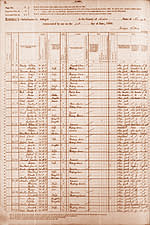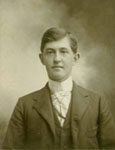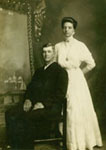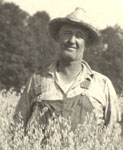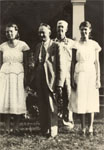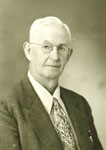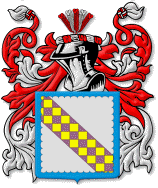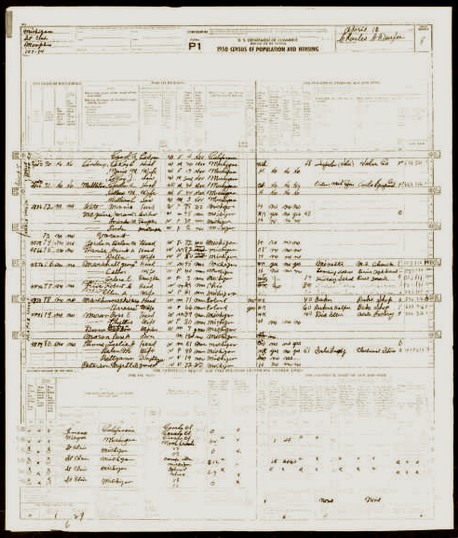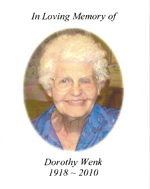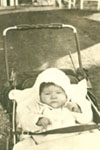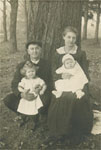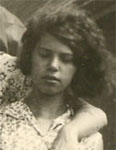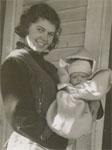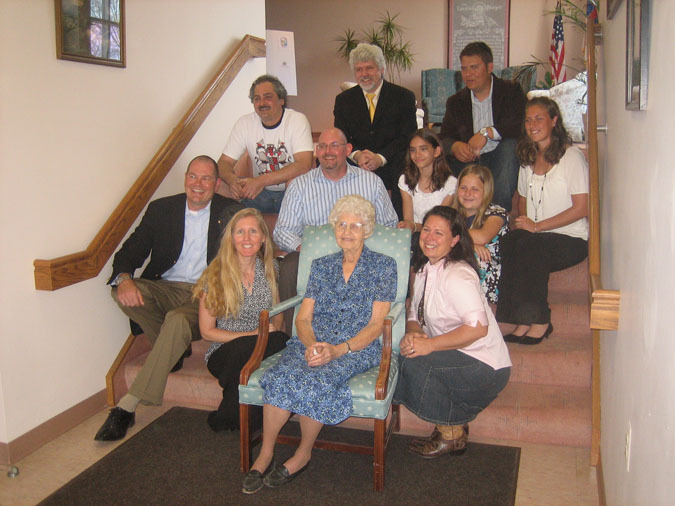
 |
| Pritchard |
|
|
Pritchard is a Welsh surname—an Anglicized contraction of the Welsh term ap Rhisiart, meaning son of Richard.¹ This makes genealogy of the Prichard surname (and the variant in our line, Pritchard²) in Wales very tough, because there were a lot of Richards—and even more sons of Richards.
The name Richard itself is derived from the Old German Ricard, a compound of the elements ric (power), and hard (hardy, brave, strong). It was found occasionally in pre-Conquest Britain as Ricehard, but Burke's Landed Gentry asserts that the surname Prichard was first recorded in Llanover (now Pwllywrach), Glamorgan County, in South Wales, where the family was seated from very ancient times, before the Norman Invasion and the arrival of Duke William at Hastings in 1066 A.D. An early Coat of Arms, shown at left, is Ermine (silver or white) with a black lion rampant. Another black lion is featured in the Crest. The Family Motto, "Labore et fide," translates as, "With labor and faith"—and the Prichards have displayed both qualities in abundance over the centuries.
The first recorded spelling of the family name is shown to be that of David Aprycharde, which was dated 1521, in the "Oxford University Register", during the reign of King Henry VIII. Notable bearers of the name include: Sir William Pritchard, Lord Mayor of London, 1682; and Hannah Pritchard (1711 - 1768), actress, who played at Drury Lane, London, and was held to be the greatest Lady MacBeth of her day.
The following family line begins before the name Prichard—or any surnames, for that matter—even existed. Surnames became necessary when governments introduced personal taxation. In England this was known as Poll Tax. This way, the "ap Richard" couldn't point to the elder Richard's name on the list and claim he'd already paid his tax. Anyway, here is Wales' most famous Pritchard line (keep in mind this is just one line of sons, and it's unclear where or when our line broke away):
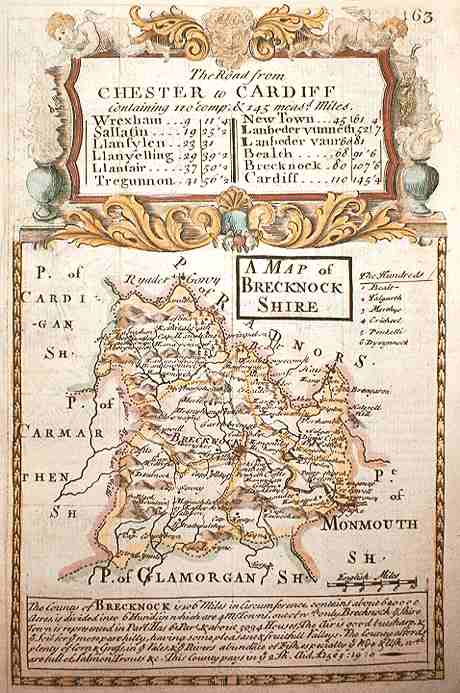 |
It all starts with GWENLLIAN (remember this name), the seventeenth daughter of BRYCHAN and the wife of LLYR MARINI, a chieftain of the North of England. Gwenllian gave birth to CARADOC VRAICH VRAS, who became Earl of Hereford and Prince between Wye and Severn, reigning from 520-570 AD. "Caradoc of the Brawny Arm," as he was called, was the founder of a dynasty of princes who ruled over Brecknock (now called Breconshire—the home of our earliest confirmed Pritchard ancestors), until the after the Norman Invasion, when his descendant BLEDDIN was slain in 1090. In legend, Caradoc was the king of the Cornish Britons during the reign of King Arthur, and a Knight of the Round Table. He married TEGAU-EURVRON (meaning "Fair one, silver breasted"), the daughter and sole heir of BELENAUR, King of Monmouth (the county northeast of Glamorgan in the map at right), and through this union became "lord of Gloucester." He then claimed the sovereignty of the province of Brecheiniog by his maternal descent from Brychan. He founded the family residence in Llanover, called Cwrt Over (Gover's Court, which came to be known as simply "The Court"), which would remain in the hands of his heirs for over a thousand years. Don't believe me? Read on...
Their son, CAWRDAF AP CARADOC, was Prince between Wye and Severn—as was his son, GLOYW AP CAW. His son, HOYW AO HOYW, was also the Prince of Wye and Severn, and governed Fferregs about 640, AD.
The line continued with CYNFARCH AP HOYW, who lived about 680 and was the Prince of Wye and Severn—as was his son, CYNDEG AP CYNFARCH.
TEITHWALCH AP CYNDEG inherited those principalities from his dad, and then assumed the government of Fferregs and Brecknock. His country was invaded by King Offa. Prince Teithwalch repulsed the invaders, however, as was the invasion of Fferegs by the Mercian Prince Ethelbald.
His son, Prince TEGID AP TEITHWALCH lived about 780. And his son, TANGWYDD AP TEGID, was Prince of Brecon (Breconshire), Regulus of Radnor and Builth. During his rule, Wales suffered from incursions by Egbert, King of the West Saxons.
ANARAWD AP TANGWYDD was Prince of Brecon and Regulus of Radnor and Builth—as was his son, GWENDYDD AP ANARAWD, who lived about 860, AD.
His son, GWENGY AP GWENDYDD, was Prince of Brecon, and reigned about 890 and 896.
His eldest son, HYDD HWGAN AP GWENGY (Sir Huganus "of John de Cast"), was Prince of Brecon, but in 914 he was defeated by Ethelfreda, wife of Ethelfred, Earl of Mercia, and his castle of Brecenamere was taken by storm. The Prince and his troops rallied at Derby, but he was finally slain by Ethelfreda.
His son, DRYFFYN AP HWGAN, was Prince of Brecon, and was one of the eight tributary princes known in English history for rowing King Edgar down the river Dee. He married the Princess CHRISLY AP MEYRIC AP EDWAL, and had at least two sons:
CHILDREN OF DRYFFYN AP HWGAN and CHRISLY AP MEYRIC |
| BLEDDYN, who married ELINOR, daughter of TEWDWR, MAWR, and sister of Rhys AP Tewdwr, Prince of South Wales, aunt to the Princess Nesta, wife of Henry I. Bleddyn was slain in 1090 by Bernard Newmarch, one of King William's barons, at a place called "Battle" on the Usk. He was buried in the Abbey of Strata Florida. |
| RHYS GOCH, Lord of Ystradwy (now the hundred of Crickhowel). He married JOAN, daughter of CADWGAN AP ELYSTAN GLODRYDD. Family listed below. |
Rhys Goch and Joan had a son, CYHYLLEN VOEL AP RHYS, Lord of Ystradwy, living in 1056.
RHYS AP CYHYLLEN VOEL, his heir as the Lord of Ystradwy, married ANNE, daughter of MOVEIDDIG WARWYN, by ELINOR, daughter of REES AP TUDOR MAWR, Prince of South Wales.
The next heir, CYNHYLLIN AP RHYS, married JANET, daughter of HOWEL, Prince of Cærleon, in about 1180.
Their son, CYNFYN AP CYNHYLLIN, Lord of Ystradwy, married GLADIS, daughter of SITSILLT AP DYDNWAL, Lord of Upper Gwent.
ARTHER AP CYNFYN, Lord of Ystradwy and Ynis Ellan, married ELEN, daughter of MEYRIC AP CRADOC.
HOWEL AP ARTHER married JONANNE, daughter of GRONOW of Llowarch, Lord of Cybor, Glamorgan.
Their eldest son, GRIFFITH AP HOWEL, was also called "Dew, a Theg, the fat and handsome." He married JANNETT, daughter and heir of GRONOW YCHAN, Lord of Penrhos Fwrdios Castle, near Cærleon. She apparently had no problems with having a husky husband. (Penrhos Castle continued to be the seat of the family until late in Queen Elizabeth's reign.) Griffith was slain by Gilbert de Clare, in 1282, AD Maybe if he had been the fit and handsome he might have won the battle.
His son, DAVID AP GRIFFITH of Penrhos Castle, married MAUD, daughter of LLEWELYN AP CYNFRIG YCHAN, of Llansamlet, by the co-heiress of SIR RALPH MAELOG.
Their eldest son, HOWEL GAM AP DAVID, was living at Penrhos Castle in 1326 and engaged in levying troops for Edward II. He married JOAN, daughter of ADAM AP RHYS AP EINEM SAIS. After that he married JOYCE SCUDAMORE.
His eldest son by his first marriage, HOWEL YCHAN, married JANE NORRIS, daughter of SIR JOHN NORRIS, of Penllyne Castle, Glamorgan co. He died before 1399, with only a son:
MEURIC AP HOWEL YCHAN, who married GWENLLIAN, daughter of GWILYM AP JENKYN, alias Herbert, Lord of Gwernddu.
Their eldest son, IEVAN AP MEURIC, was living in Penrhos Castle in 1433 when he married JOAN, daughter of LLEWELYN YCHAN AP MADOG AP HOWEL YCHAN. They had two sons:
CHILDREN OF IEVAN AP MEURIC and JOAN |
| TRAHEARNE, Deputy Steward of Cærleon in 1454, Penrhos Castle and estate, which descended from him to Sir Roger William. |
| HOWEL AP IEVAN, Lord of Llanover, of Curt y Pothir (i.e. the court with the long porch). He married JANE. Howel was buried in the Abbey of Strata Florida. Family listed below. |
JENKYN AP HOWEL of Llanover Court married the daughter of GWILYM AP DAVID GWARIN, of Lanfoyst.
Their eldest son, RICHARD AP JENKYN, of Llanover Court, married ANNE, daughter of WILLIAM AP JOHN AP ROGER, Lord of Gwemdda, High Sheriff for Brecon in 1554, by MARGARET, daughter of LEWIS PHILIP, both of which families were lineal male descent from the house of Herbert. Their eldest son began the "Prichard" line.
WILLIAM AP RICHARD (or, note the first use of the family name: AP RICHARD), of Llanover Court, married ELIZABETH, heiress of WATKINS AP HUGH, of Killwch (by his 2nd wife, MARGARET, widow of John Griffiths, and daughter of SIR RICHARD HERBERT, of Ewyas. (So Elizabeth was of the house of Herbert by father and mother!) They had:
CHILDREN OF WILLIAM PRICHARD AND ELIZABETH |
| MATTHEW PRICHARD. Died in 1622. Family listed below. |
| CHARLES PRITCHARD, vicar of Llanover, 1583. |
| ANNE PRITCHARD (no further information). |
William was buried at Llanover, where his memorial brass is still shining over his tomb with the inscription, "Here lyeth the bodies of William Prichard, of Llanover, Esq., and of Matthew Prichard, of Llanover, Esq., his sonne and heire, lineally descended from the body of Cradock Vraiche Vras, Earle of Hereford, and Prince between Wye and Severne."
His eldest son, MATTHEW PRICHARD, of Llanover Court, was High Sheriff of Monmouth county in 1596. He married SISSYLT, daughter of EDWARD LEWIS of Vann, Glamorganshire (who was High Sheriff in 1548, 1555, and 1559) by ANNE, daughter of SIR WILLIAM MORGAN of Pencoed Castle. They had:
CHILDREN OF MATTHEW PRICHARD AND SISSYLT |
| WILLIAM PRICHARD of Llanover Court and Goytrey Manor, was ruined by paying the fines of the royalist prisoners, and sold the estate of Llanover. His daughter, Maud, was baptized at Goytrey on November 22, 1617. The address to Oliver Cromwell, in 1655, was signed by "William Prichard of Monmouthshire." |
| JENKIN or JOHN PRITCHARD, was baptized April 2, 1599. He was Captain in the army of Charles I. At the destruction of Reglan Castle in 1646, he sent his infant son, WILLIAM PRICHARD, to Chorley, in Lancashire, in the care of a collector of excise. His son, THOMAS PRICHARD, married MISS. DALRYMPLE, niece of the Earl of Stair, and resided in Hampton Court. Another son named WILLIAM PRICHARD was mayor of Preston in 1643. |
| BENJAMIN PRITCHARD suffered voluntary exile during the Commonwealth after the destruction of Reglan Castle. But at the Restoration, he returned and obtained the estate known as Manor House of Goytrey, within the Llanover Manor. |
As you can see, the fortunes of the Prichards changed drastically. In 1730, Benjamin's son, WILLIAM PRICHARD (b. 1686), finally sold Goytre Manor—the only remaining part of the ancestral estate held by the Prichards at Llanover—to Charles Hanbury Williams, and went to reside at "The Hill," Trostrey, New Llanover.
From this point on, this branch of the Prichards and their descendants had no ancestral home, and spread across the British Empire—and even into New England. And it becomes extremely difficult to chart a particular family history, because there are hundreds of Prichard families in Wales. Our ancestors toughed it out in Breconshire for another 150 years (and added a "t" to the surname along the way). We find them sixty years after the sale of the manor, living in Breconshire, and in much poorer circumstances. Here's what we know:
OUR PRITCHARD FAMILY
 Mist hanging over the village of Abergwesyn in Wales. Inset, L-R: St. David's (Llanddewi, Abergwessin), where David Pritchard married Gwenllian Thomas in 1824 (2); Graves in the church yard; An engraving of Builth in 1830—Llanelwedd lies on the left bank of the River Wye. The stone quarry where David worked is on the left.
Mist hanging over the village of Abergwesyn in Wales. Inset, L-R: St. David's (Llanddewi, Abergwessin), where David Pritchard married Gwenllian Thomas in 1824 (2); Graves in the church yard; An engraving of Builth in 1830—Llanelwedd lies on the left bank of the River Wye. The stone quarry where David worked is on the left.
|
"LLANDDEWI-ABERGWESSIN (LLANDDEWI-ABER-GWESYN), a parish, which comprises one of the wildest and least cultivated tracts in the county, derives its name from the dedication of its church, and from the little river Gwessin, near the confluence of which with the Irvon the village is situated. Llwynderw, or 'the oak grove,' is a handsome residence here. Lead-ore has been found, but it is not now worked. The roads are utterly impassable for carriages, and unsafe even for common carts. The living is annexed to the vicarage of Llangammarch; the church is a very rude building, dedicated to St. David"
—A Topographical Dictionary of Wales, by Samuel Lewis (1849)
|
| Genealogical Info |
Image |
|
| Subject: |
|
David Pritchard / Gwen Thomas Genealogy |
| Author: |
|
Roger Hemmings |
| Address: |
|
1 Marianwen St., Blackwood, Gwent, NP12 3ST |
| Country: |
|
South Wales |
| Date: |
|
2005 |
|
|
|
Our lineage can be traced back to DAVID PRITCHARD, who was born sometime around 1790 in Breconshire, one of the thirteen historic counties of Wales, in a tiny village called Abergwesyn, located in Treflys, a hamlet (i.e. a rural township), at the start of the Abergwesyn valley and at the confluence of the Afon Irfon and the Afon Gwesyn rivers, 52 miles from Cardiff. David wasn't a vicar or a king or even a lord of the manor like the names listed above—he was a poor farmer who even took work in the iron quarries to put food on the table.
We are unsure of the origin of our Pritchard line, but there were people of that name in Abergwesyn long before David. There is a local legend that Rhys Prichard (1579-1644), the poet/minister who wrote Canwyll y Cymry (The Welshman's Candle) used to preach in the hills over the village; but the first record we have of someone with the Pritchard surname living in the area was an early 18th Century vicar for Llangamarch, Llanwrtyd, and Llanddew with the sing-songy name of Richard Prichard. In A History of Brecknockshire (1909), author Theophilus Jones makes sport of the vicar's "grotesque bust" in the chancel of Carmarthen church where he is buried, and compares it to a tradesman bending over a counter. Before becoming a vicar he had been the chaplain to the 'Newcastle' at the bombardment of Calais in 1696, and to the 'Dreadnought' in 1697. In the next Century, about fifty years before David was born, Luke Prichard was licensed to serve as curate in Llanfihangel Abergwesyn and Llanafan fechan.
David's parents might have been JAMES PRICHARD (10 Jun 1744 - Nov 1824) and JANE LEWIS (1747-1819), whose marriage banns were posted on 19 Jun 1779 in the nearby Llanfihangel Tallyllyn parish in Breconshire (and they are buried there as well). In turn, James may have been the son of DANIEL and ESTHER PRICHARD of Hay-on-Wye (Y Gelli Gandryll), known locally as Hay (Y Gelli), a market town in about 30 miles from Abergwesyn. A James and sister Jane Prichard (twins?) were baptized there on 10 Jun 1744.
There are no records of David's baptism, meaning that his family was probably of a "nonconformist" denomination (most likely Congregationalists, which by 1851 was the major denomination in Breconshire). But he probably had a brother, named JOHN PRITCHARD (1791 - 1845), who married MARGARET EVANS (1792 - Mar 1881), on 24 Nov 1815 in the parish of Llanfihangel Abergwesyn (a parish is a small administrative district typically having its own church and a priest or pastor). The Pritchards lived in an area with twin parishes: Llanfihangel Abergwesin and Llanddewi Abergwesin. The village of Abergwesyn was the dividing line between the parishes, with their respective churches just a few hundred yards apart.
CHILDREN OF JAMES PRICHARD AND JANE LEWIS (?) |
| DAVID PRICHARD was born in 1790 in Abergwesyn, Treflys, Llanfihangel, Breconshire, Wales. On 19 March 1824 he married Gwenllian Thomas (1791-1881) at Llanddewi (2), Breconshire, about 16 miles from Abergwessin, in "a very rude building, dedicated to St. David." (Lewis, Samuel A., A Topographical Dictionary of Wales, 1849; pp. 505-511). Family listed below. David died in September of 1872, around the age of 83, in Treflis, the district of Builth, Breconshire Radnorshire. Gwen died at age 91, during the month of March, 1881, in the same area. |
 |
JOHN PRICHARD was born in 1791 at Abergwesyn, Treflys, Llanfihangel, Breconshire. "On the 24th of November 1815, in Llanfihangel Abergwesyn, John Pritchard, by now a farmer, married Margaret Evans, (b 1791). They went on to have five children: William b. 1816 at Goytrefan, Llanafan Fawr; Anne b. 1818 at Goytrefan, (no trace can be found); John b 1821 at Goytrefan, (no trace can be found); Eleanore/Elinor b 1824 at Gotrefan; Thomas b 1830 at Argoed. The baptisms of these children took place at the Troedrhiwdalar Chapel, Llanafanfawr; a Presbyterian chapel for dissenting Protestants. Goytrefan and Argoed were part of the Llwynmadoc estate so John and Margaret would have been tenant farmers. John Pritchard Senior died in 1845 and is buried at Troedrhiwdalar. On his gravestone it states that he was of Park Farm, Llangammarch and had been a member and Deacon of the chapel for many years. Census evidence reveals that his wife, Margaret Pritchard nee Evans died, aged 90yrs in Beulah on January 25 1881 and is buried with her husband in the same grave (A 112). She had lived in Ty Cornel 1851, Dolrannel Cottage 1861 and finally at Ty Clyd. She left the sum of £225 5s to her eldest son William who was a labourer living in Court Llwyn, Llanfilo near Bronllys, Breconshire." (Breconshire Local & Family History Society Newsletter #87, Spring 2020, "Two Centuries of Breconshire Ancestry: From Pritchard to Richards," by Myra Jones.)
|
|
| Genealogical Info |
Image |
|
| Subject: |
|
Wedding Banns |
| Name: |
|
David Prichard |
| Residence: |
|
Llanphangel Abergwessin |
| Spouse: |
|
Gwen Thomas |
| Marriage Place: |
|
Llanddewi Abergwesyn |
| Date: |
|
24 Mar 1824 |
|
|
|
SOURCE: Brecknockshire, Wales, Anglican Baptisms, Marriages and Burials, 1538-1994. Archifau Cymru: Archives Wales.
|
Fortunately for us, David Pritchard did register for weddings. A 1538 Act of Parliament required ministers in the Church of England, the established church in Wales at the time, to record baptisms, marriages, and burials. Marriage records typically include the bride and groom's names, residence, date and location of the marriage (couples were usually married in the bride's parish), names of witnesses, condition (bachelor, spinster, widow, or widower), and the name of the officiant. Thanks to this, we know today that banns were published in the Llanddewi Abergwesyn parish church for bachelor David Prichard to marry spinster GWEN THOMAS on 19 Mar 1824. The publication of banns involved announcing aloud the intended marriage during a church service on three successive Sundays preceding the ceremony. The congregation was invited to register objections. (Fortunately for us, there were no complaints.) David and Gwen each signed the document with an "x" in the presence of witnesses David Davies and John Thomas.

.gif) |
| Thomas |
|
|
Gwen's surname, "Thomas," is from the medieval personal name, of Biblical origin, and from Aramaic t’om’a—a byname meaning ‘twin’. In Britain, the surname is widely distributed throughout the country, but it's especially common in Wales, where the Thomas surname was first found in, conveniently, Breconshire (so obviously Gwen's family hadn't moved around much over the centuries). The Thomas family in Wales claims descendance from folk hero Owen Glendower, Lord of Glyndwyrdwy, the last native Welsh person to hold the title Prince of Wales. He instigated an ultimately unsuccessful but long-running revolt against English rule of Wales. Despite enormous rewards being offered after the revolt, he was never captured nor betrayed, and he ignored Royal Pardons. (Ironically, he placed 23rd in a poll of the 100 Greatest Britons in 2002.) The Thomas coat of arms is silver, with a black chevron between three Cornish choughs. On the crest is another Cornish chough. The family motto, "I dduw bo'r diolch," translates as "To God be thanks."
The first recorded person of this heritage in the Powys area was named Evan Thomas ap Meredith (1610-1676), an Abergwesyn farmer. While he was a poor yeoman, his children married well and became landowners, whose descendants prospered in the area for the next 200 years. Our family lore, however, says that our Thomas ancestors and Pritchard ancestors were actually from Scotland, but there is no evidence that we can point to, and Thomas and Pritchard families are recorded in the area's Non-Conformist church histories.⁴
Gwen (or GWENLLIAN, b. 1791) was possibly the child of DAVID THOMAS and CATHERINE JONES, who were married at Llanddewi Abergwesyn on December 1, 1774. A Gwen Thomas was baptized there on 28 Mar 1790 to David Thomas—with no mother named. But David was listed as a parent with Catherine Jones for the baptisms of Ann Thomas on 4 Jun 1793, and Rees Thomas on 26 Mar 1797, so it's a good bet that she was Gwen's mom, too. The Thomas family was probably a "nonconformist," as well, because they didn't baptize any children in the parish church, either. The parish church, St. Michael's, contained several notable monuments to the Thomas family of Llwynmadoc dating back to the seventeenth-century, but we can't be sure if it was the same Thomas gamily as Gwen's. (The parish church was demolished in 1964—but the churchyard remains, containing a memorial cross to the Thomas family.)
"BEULAH. Llanwriyd and Abergwesyn districts in Breconshire have become a haven for creatures rarely seen in other areas. Here badgers are allowed to breed unmolested and undisturbed by the local farmers, and kites, buzzards and ravens are quite common."
—'Western Mail,' Cardiff, Glamorgan, Wales, Wednesday 23 Feb 1955, Page 4, Column 8.
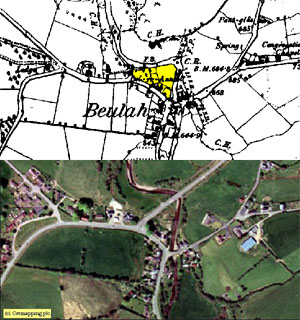 |
Treflys was only a small settlement (its population by 1851 will still be under 500) and covered an area of over 6000 acres, so people weren't that hard to trace. Street addresses weren't necessary in order to find anybody, and none were recorded for any Wales census. The Prichards were living at Dol-Yr -Annel Fach in the village of Beulah, which is shown at right in an 1890 map with a modern aerial view underneath (Fach means 'little'—so they were living in the little house there).
The '71' enumeration on the map reveals: Beulah was their post office; Ty clyd(2); Dolrannel—pub per the heads occupation; Dolrannel fach(2); Aberannel Lodge. They lived in an individual house, as defined by a I in the inhabited column. Dol-Yr-Annel on the old map is highlighted in yellow, just above the end of the word Beulah. The people of the area would have nearly all been involved in working on the land in some way. For farm laborers and servants, ordinary life would not have changed much in the previous hundred years. They would almost certainly have been Welsh speakers, with little or no English in use. The Welsh language is in the Celtic language group, whereas English is in the West Germanic group; consequently the English language is further from the Welsh language in both vocabulary and grammar than many European languages.
David worked as a farm laborer and quarryman in Breconshire (then called Brecknockeline), on the very land "Caradoc of the Brawny Arm" once ruled. A booming iron industry made this area one of the most heavily industrialized in the country in the late 1700s, with Merthyr Tydfil as the center. Coal mines and slate quarries were also plentiful. Over the next century, canals were dug from the mines and quarries to the rivers, and railroad lines were built from the mines to the seaports. Soon, Welsh minerals were being shipped all over the world. So even if there was little money in Wales, there was plenty of work.
David and Gwen had six children somewhat late in life, beginning when David was 35 and Gwen about 30. Being nonconformist, their children weren't baptized in the parish church, but here's a listing of their children, with dates from other sources:
CHILDREN OF DAVID PRITCHARD AND GWEN THOMAS |
| MARGARET PRITCHARD was born @ 1824 in Wales. She worked as a farm labourer. |
|
WILLIAM PRICHARD (no 'T') was born on 03 Aug 1826 in Tyn Llan, Brecknockeline, Wales. He traveled to America and married a woman named MARGARET GRIFFITH (20 Oct 1831 - 12 Dec 1886) on 20 Jan 1853 in Radnor, Delaware, Ohio. They had ten children: Mary (1854-1883), Sarah (Jones, 1856-1930), Ellen (Cox, 1857-1948), David (4 Dec 1858 - 9 Nov 1927), William W. (1860-1918), Anna (Ransome, 1862-1931), John (1864-1919), Benjamin (1866-1910), Margaret (1868-1946), and Gomer Prichard (1873-1932). He worked as a "huckster" and united with the Radnor Baptist Church in 1857, and served as a deacon for 19 years. William died on 01 Nov 1899. He and Margaret are buried at Radnor Cemetery in Radnor, Delaware County, Ohio.
|
| ELEANORE PRITCHARD was born in 1830 and became a house servant. In 1871, she was still unmarried, taking care of her parents at their home (according to that year's census). |
| DAVID PRITCHARD (with a 'T') was born on 27 Jun 1830 in Breconshire, Wales. He sailed to the United States in 1859 and was a 28-year-old boarder at the house of Thomas Edwards in Radnor, Delaware, Ohio, in the 1860 census. In 1863 he registered for the Union Army during the Civil War, was Naturalized in 1869, and became an agricultural laborer in Radnor and married ELEANOR "ELLEN" (1835-1 Oct 1872) and they raised JOSEPH (b. 1863) and EDWARD (b. 1865) (possibly David's stepsons, per the 1880 census), and WILLIAM D PRITCHARD (26 Jul 1871 - 5 May 1926). Eleanor died on 1 Oct 1872 and in 1874, David married ANN (b. 1840), another recent transplant from Wales (1870). David died on 27 Sep 1914 and is buried at Radnor Cemetery in Radnor, Delaware, Ohio. |
|
JOHN PRITCHARD (with a 'T') was born on 07 Oct 1832 in Llanvihangel Abergwerin. He became a farm servant and married a woman named CAROLINE in Wales.³ They sailed to America, and she died during the journey or soon after. John then married MARY MALISSA MILLER of Pennsylvania on 03 Oct 1872 in Missouri. They moved to Saunemin, Illinois, and had seven kids, listed below. John died on 11 Mar 1897 in Illinois. His story can be read in Portrait and biographical album of Livingston County, Ill., published by the Chapman Bros., Chicago (1888), pages 895 and 896.
|
|
THOMAS PRITCHARD (with a 'T') was born on 03 Mar 1833 in Wales. He was an apprentice to blacksmith Thomas Jones in the 1851 Wales census at Bronrefel in the Parish of Llanfechan, Breconshire. He sailed to America in 1855 and married MARGARET JANE JONES (1835-1910) of Radnor, Delaware County, Ohio, near the home of his brothers William and David. Thomas and Margaret had: Martha A (Griffith, 1857-1885). Thomas then was in the Union Army during the Civil War, after which he resumed having children, including Margaret Jennie (O'Briant, 1866-1951), David (1867-1930), Mary (Jenkins, 1872-1958), Nancy "Nannie" (1875-1886). James (1876-1960), and Eleanor Margaret Pritchard (Sutton, 1880-1983). Thomas then married SARAH REESE on 19 Apr 1883 in Livingston County, Illinois, near the home of his brother John. He died on 12 Sep 1912.
|
"Years ago the hillsides were dotted with small holdings and thatched houses, in many cases with clod built walls and clay floors... these were inhabited, and in many lived large families... These houses have all disappeared and the people on the land have been obliged to go to the industrial centres to obtain a living."
—Brecon County Times article on the churches of Abergwesyn, dated 16 Nov 1922
|
| Personal Information |
Census Image |
|
| Name: |
|
David Prichard |
| Age: |
|
50 |
| Where born : |
|
Breconshire, Wales |
| Civil Parish: |
|
Llan gammarch |
| Hundred: |
|
Builth |
| County: |
|
Breconshire |
|
|
|
|
SOURCE INFORMATION: 1841 Wales Census. Data imaged from the National Archives, London, England. Source information: HO107/1365/15; Registration district: Builth; Sub-registration district: Abergwessin. ED: 9. Folio: 12. Page: 8. Line number: 4. GSU Number: 464299.
|
|
Despite the noble origins of their supposed ancestors, they were not a rich family. Wales was a poor country—with their area being one of the poorest—and an economic depression in 1829 made conditions even worse. The Pritchards were still better off than most, however. They lived off the land, while most of their neighbors had been forced to move into larger cities to live in ramshackle housing, and work in factories under horrible sweatshop conditions for little pay. Before long, riots broke out. The Merthyr riots of 1831 were the bloodiest industrial riots in British history. The Chartist riots came next, when police shot and killed dozens of the 5000 men marching on Newport to demand a charter granting the Welsh voting rights and equal representation in Parliament. But the farmers in rural areas soon began protesting as well. The Rebecca Riots of 1839 were staged in response to tolls charged to farmers as they moved their animals through the countryside. Tollgates had been set up along the way, charging heavy fees. In the dark of night, farmers dressed up as women destroyed the tollgates. We have no word on whether or not David ruined any of Gwen's dresses during the protest.
By 1841, the combined population of the parishes of Llanfihangel Abergwesin and Llanddewi Abergwesin was about 450 people. In the census of that year, 50-year-old David (last named spelled "Prichard") is an agricultural laborer at Panteg (small field) in Treflys, meaning he grew and rotated crops of grains and corn, and probably raised sheep—an occupation so prevalent in Abergwesyn that the farmers would actually bring their dogs to church services! 45-year-old Gwen is raising John, age 8, and Thomas, age 7. Margaret (15) and Elinor (16) are servants at Llwyn Gwilyn, Llangamarch—as was the custom of the time, the children received very little schooling and instead they all began servant-hood at an early age to support the family. There obviously weren't going to be a lot of career opportunities for the Prichard children in Wales, "t" or no "t" in the last name.
Meanwhile, David's brother John and his wife, Margaret, were living next door. Sadly, John would die before the next census, some time asround 1846...
|
| Personal Information |
Census Image |
|
| Name: |
|
David Pritchard |
| Age: |
|
62 |
| Where born: |
|
Llanfl Abergwesin, Breconshire, Wales |
| Township: |
|
Llanfihangel Abergwessin |
| Occupation: |
|
Quarryman |
| County: |
|
Breconshire |
|
|
|
|
SOURCE INFORMATION: 1851 Wales Census. Data imaged from the National Archives, London, England. Source information: HO107/2488. Registration district: Builth. Sub-registration district: Abergwessin. ED, institution, or vessel: 2. Folio: 11. Page: 1; Household schedule number: 2. GSU# 104248
|
|
| Personal Information |
Census Image |
|
| Name: |
|
David Pritchard |
| Age: |
|
71 |
| Where born: |
|
Llanfihangel Abergwesin, Cardiganshire, Wales |
| Township: |
|
Llangam-march |
| Parish: |
|
St. David |
| County: |
|
Breconshire |
|
|
|
|
SOURCE INFORMATION: 1861 Wales Census. Data imaged from the National Archives, London, England. Source information: RG9/4205; Registration district: Builth; Sub-registration district: Abergwessin. Household schedule #51, GSU #543250
|
|
| Personal Information |
Census Image |
|
| Name: |
|
David Pritchard |
| Age: |
|
81 |
| Where born: |
|
Abergwessin, Breconshire, Wales |
| Civil Parish or Township: |
|
Llangammarch |
| Town: |
|
Treflis |
| County: |
|
Breconshire |
|
|
|
|
SOURCE INFORMATION: 1871 Wales Census. Data imaged from the National Archives, London, England. Source information: RG10/5573; Registration district: Builth; Sub-registration district: Abergwessin.
|
|
Most early records list David's last name as "Prichard," the traditional spelling, like his probable father, but by 1851 the modern spelling of the family name, "Pritchard," was being used. By the 1851 census, David is listed as a 62 year-old quarryman, and has the "t" now added to his last name, living with Gwen at Hafod in Treflys. Elinore is a 23 year-old house servant, living "a few doors" from David and Gwen. Their daughter Margaret lives farther away as a 25-year old housekeeper. As for the male children, William (23) and John (as "John Prichard," still the old spelling, age 19) are listed as an unmarried servants, but Thomas (16) is apprenticing as a blacksmith. David's brother, John had died, and his wife Margaret was living alone as a widow.
In the 1861 Wales census (shown above), 71-year-old David and Gwen were living with widow Margaret Pritchard at Dolrannel Cottage. David and Gwen's daughter Eleanor, 33, was employed as a house servant and living with them. David himself was still farming in the 1861 census, when he was over seventy years old!!! The gradual superseding of iron by steel led to a decline in the iron trade and the closing down of local quarries in the 1860s. In the 1871 census David has finally retired, listed as an "ex-quarryman," although he probably still farmed to put food on the table.
According to the England and Wales Civil Registration Index: 1837-1983, David died in September of 1872, around the age of 83, in Treflis, the district of Builth, Breconshire Radnorshire. Gwen died at age 91, during the month of March, 1881, in the same area (as did her sister-in-law, Margaret Pritchard, age 89, who is on the same page of the index as Gwen). They had lived long, hard-working lives, and witnessed the rise of the Industrial Revolution—but as we shall see, it took a great toll on their family... many of whom had already left Wales, never to see their parents or their native country again.
| Personal Information |
Death Record |
| Name: |
|
David PRITCHARD |
| Age at death: |
|
83 |
| Estimated. birth year: |
|
1789 |
| District: |
|
Builth |
| County: |
|
Breconshire, Powys, Radnorshire |
| Volume: |
|
11b |
| Page: |
|
55 |
| Year: |
|
1872 (Jul-Aug-Sep) |
|
|
|
| Personal Information |
Death Record |
| Name: |
|
Gwen PRITCHARD |
| Age at death: |
|
91 |
| Estimated birth yr.: |
|
1790 |
| District: |
|
Builth |
| County: |
|
Breconshire, Powys, Radnorshire |
| Volume: |
|
11b |
| Page: |
|
67 |
| Year: |
|
1881 (March) |
|
|
|
SOURCE INFORMATION: General Register Office. England and Wales Civil Registration Indexes. London, England: General Register Office.
|
"John Pritchard, now a resident of Saunemin township, is a native of Wales, in which country he resided until 28 years of age. He was born on the 7th day of Oct 1832 and is the son of David and Guine Pritchard. The former native of Wales, but of Scotch ancestry as was also the mother. To the parents were born 6 named Margaret, William, Eleanor, David, John and Thomas. The Pritchard family are all long lived people. The father having reached 85 years and the mother 90."
—Portrait and Biographical Album of Livingston County Illinois pages 895, 896.
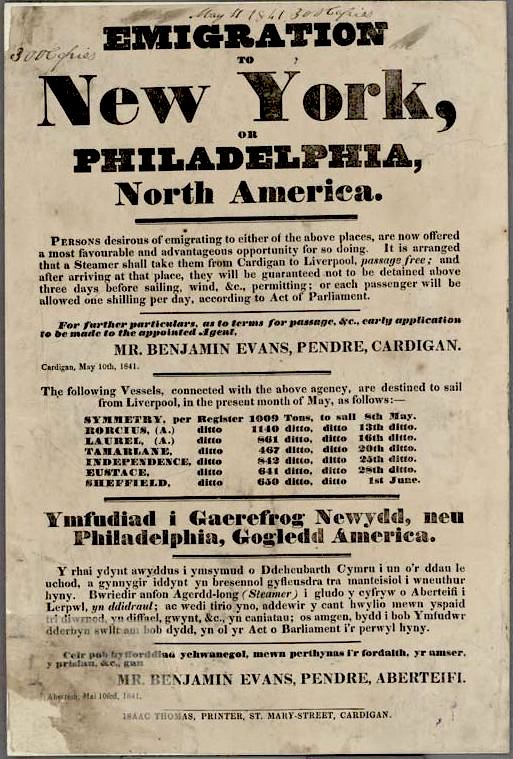
An 1841 poster advertising passage to America, written in English and Welsh (Source: National Library of Wales). |
The population of Wales had almost doubled in the first fifty years of the 19th Century, from 587,128 people in 1801 to 1,162,139 in 1851, due mainly to industrialization. At the same time, the competition for work and the resulting low pay had also caused a jump in emigration to North America. In the decade between 1820-1830, only 170 Welsh were recorded as entering the United States as immigrants. But by 1850, that figure had gone up to 1261. In the decade of 1851-60, that figure jumped 600%, when as many as 6319 Welsh entered the U.S. as immigrants, most of them 'industrial', and many in the Pritchard family were among the exodus. There was no land for the children of David and Gwen to inherit and work, let alone expand, so they set out for better opportunities... but after emigrating, those children would find their new lives no less hard.
One son, JOHN PRICHARD, was listed as an 18-year-old farm servant in the 1851 Wales census at Llwyncus, in the Hamlet of Trefryn. But by the end of the decade, John and his brothers would move our Pritchard line to America. John married a woman named CAROLINE in Wales (at least according to the passenger list from the ship he emigrated on), but she apparently died before 1872, when John remarried in the United States. It's doubtful that he ever heard from David or Gwen again after he sailed for America in the 1860's, and much of our earlier family history is now lost forever.
|
| Personal Information |
Census Image |
|
| Name: |
|
John Prichard |
| Age: |
|
8 |
| Where born : |
|
Breconshire, Wales |
| Civil Parish: |
|
Llan gammarch |
| Hundred: |
|
Builth |
| County: |
|
Breconshire |
|
|
|
|
SOURCE INFORMATION: 1841 Wales Census. Data imaged from the National Archives, London, England. Source information: HO107/1365/15; Registration district: Builth; Sub-registration district: Abergwessin. ED: 9. Folio: 12. Page: 8. Line number: 4. GSU Number: 464299.
|
|
| Personal Information |
Census Image |
|
| Name: |
|
John Prichard |
| Age: |
|
18 |
| Where born: |
|
Llanvihangel Abergwerin |
| Civil Parish: |
|
Llanlleonfel |
| Occupation: |
|
Servant, Farm Hand |
| County: |
|
Breconshire |
|
|
|
|
SOURCE INFORMATION: 1851 Wales Census. Data imaged from the National Archives, London, England. Source information: HO107/2488. Registration district: Builth. Sub-registration district: Abergwessin. ED, institution, or vessel: 2. Folio: 11. Page: 1
Household schedule number: 2. GSU# 104248
|
| Personal Information |
Passenger List |
| Name: |
|
John PRITCHARD |
| Age: |
|
31 |
| Arrival Date: |
|
16 Mar 1859 |
| Port of Departure: |
|
Liverpool, England |
| Place of Origin: |
|
Great Britain |
| Ship Name: |
|
City of Washington |
| Port of Arrival: |
|
New York |
|
|
|
|
SOURCE: New York. Passenger Lists of Vessels Arriving at New York, New York, 1820-1897. Micropublication M237. Rolls # 95-580. National Archives, Washington, D.C. (Line: 48;
Microfilm Roll: 190; List Number: 152).
|
|
The following biographical data on John Pritchard is from the book, Portrait and Biographical Album of Livingston County Illinois: "Our subject was reared to manhood in his native country, where he was given a meager education in the schools of that day. In 1860 he concluded to transfer his place of residence from the country of his birth to the United States, and taking passage on the steamship 'City of Washington', at Liverpool [the original passenger list is at left—note that John was married to CAROLINE at the time of arrival³]. He landed at Castle Garden, N.Y., after a stormy voyage of two weeks across the ocean.⁵
John first lived in western Pennsylvania, where he dug wells for a living. The industrial development of Pennsylvania, especially of the coal and iron industries, had attracted Welsh industrial workers who were seeking the comparatively high wages available in the United States. His biography states that he traveled from New York directly to Delaware County, Ohio, and there remained for seven years, "being employed as a farm hand and performing such kinds of work as he was able to secure." In 1866, John moved on, settling on an 80-acre farm in Illinois just north of the Vermillion River, five miles southwest of the town of Saunemin. From out his his poor beginnings, he was now a land owner!
|
Mary and John Pritchard, with children; then a few years later, John has lost a wife and a lot of hair in the process of raising seven children by himself.
|
Before he could get too settled, John heard that there was a need for well diggers in Missouri. Needing money to improve his new property, John traveled there and met his next bride, MARY MALISSA MILLER, of Cooper county, Missouri. He was almost double her age, as she was 21 years old—19 fewer than John. Despite the age difference, they married on 3 Oct 1872, then traveled back to the Pritchard homestead in Illinois by oxen team, and lived in a small log cabin at the north end of his property.
In 1876, the Vermillion river overflowed, flooding the cabin and stable. Family legend has it that John climbed into a wooden washtub and paddled around the farm, until finding a high spot of land near the original bank of the river at the southeast corner of the farm. He drove a stake into the ground there and built a four bedroom home on that spot. (His daughter, Margaret Pritchard-Sims, was still living in that house when she was interviewed ninety years later in 1966. She and her husband, Thomas Burr Sims, purchased the farm after John's death in 1914.)
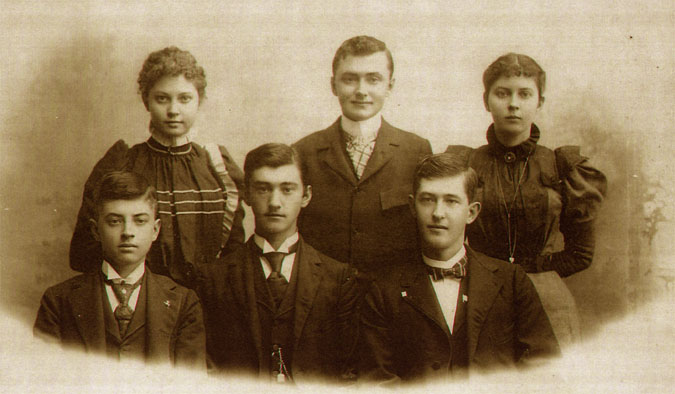 |
CHILDREN OF JOHN PRITCHARD AND MARY MILLER |
|
JOHN BAPTISTE PRITCHARD was born on 23 Sep 1873. He moved to California and married IDA KENBECK (18 Feb 1891 - 06 Jul 1915). They had a daughter, ROBERTA JUNE PRITCHARD (b. 03 Jun 1915 in Sacramento, CA) m. Marion L. Mazzoni (1908 - 1969). Roberta and Marion had a son, John James, on 13 Sep 1939 in Solano, CA. John B. died on 01 Mar 1945 in San Francisco, California.
World War I draft registration.
|
|
MARGARET E. PRITCHARD was born on 09 Jan 1876. She married THOMAS BURR SIMS (1873-1957) and they moved southeast of Saunemin. After the death of her father, John, they purchased his farm and moved back. Margaret and Burr had a daughter, MARY EDNA SIMS, in 1912, and ran the family farm into the 1960s. Margaret died in 1966, and Mary and husband Lester Ellington then took over the farm.
Mrs. Sims Notes 90th Birthday: On Same Farm Where She Was Born.
|
|
DAVID JAMES PRITCHARD was born on 12 Apr 1878. He married KATHERINE L. TRONCE (b. 28 Mar 1883) and they had a son, MARION CLARK PRITCHARD, in 1908. Marion m. Iris Sullivan (1909-2001): two sons James Clark Pritchard b.1932, William Gerald b. 1936. David died in 1941. Katherine died in Apr 1989 in Pontiac, Livingston, Illinois.
World War I draft registration.
|
|
WILLIAM CLINE PRITCHARD was born in 1880. He married NELLE WINTERS in Saunemin, Livingston, Illinois, and they had two daughters, DOROTHY and HELEN. The family moved to Washtenaw County, Michigan, and William went into politics, becoming a Justice of the Peace. William died on 23 Jun 1958 in Chelsea, Washtenaw, Michigan.
See William the politician working here.
|
|
FRANKLIN THOMAS PRITCHARD was born on 26 Feb 1882 in Saunemin, Illinois. He married LUCY SHEPPELMAN (b. 05 Mar 1898) on 18 Dec 1918 and they had two children: WILMA ELAINE (b. 13 Aug 1921) and DURELLE FRANK (b. 15 Apr 1937). Franklin died on 10 Aug 1951. Lucy died on 14 Oct 1994 in Pontiac, Livingston, Illinois.
World War II draft registration.
See Frank as a cowboy.
|
|
MARY JANE PRITCHARD was born on 17 Oct 1884 in in Saunemin, Livingston County, IL. She married WILLIAM IMMKE (14 Oct 1877 - 30 May 1963) and they ran a farm in Saunemin. Mary Jane and William had the following children: ARNOLD EARLE (6 Jul 1905 - 22 Mar 1966) and CLARENCE W. IMMKE (12 Nov 1910 - Sep 1976). Mary Jane died on 6 Feb 1953 in Saunemin, Livingston, Illinois.
|
|
LIVINIA MARTHA PRITCHARD was born on 12 Oct 1886 in Saunemin. She married JOSEPH ELMER ALBIN (11 Mar 1880 - 30 Mar 1944) at Clarksburg, Missouri, on 26 Sep 1906. They had four kids: SUDIE RITH (b. 07 Oct 1907), FLOYD (24 Dec 1908 - 29 Nov 1996), GRACE (24 Jun 1909 - 25 Oct 1909) and ALBERT (02 Dec 1921 - 08 Dec 2003). Livinia died on 12 Aug 1978 in Tipton, MO. She and Joseph are buried at New Zion Cumberland Presbyterian Church Cemetery (also called Mount Zion Cemetery) in Clarksburg, Missouri.
|
|
| Personal Information |
Census Image |
|
| Name: |
|
John PRITCHARD |
| Age: |
|
47 |
| Estimated birth year: |
|
<1833> |
| Birthplace: |
|
South Wales |
| Occupation: |
|
Farmer |
| Home in 1880: |
|
Saunemin, Livingston, Illinois |
| Spouse's name : |
|
Mary Pritchard |
| Father's birthplace: |
|
South Wales |
| Mother's birthplace: |
|
South Wales |
|
|
|
|
Year: 1880; Census Place: Saunemin, Livingston, Illinois; Roll: T9_226; Family History Film: 1254226; Page: 327D; Enumeration District: 119; Image: 0495.
|
John Pritchard prospered in Illinois, and his 80-acre farm doubled in size to 160 acres. But on the 12th of Oct 1886, Mary passed away after a short illness. John's biography noted, "She was a woman who had endeared herself by her many good qualities of head and heart to all who knew her and her loss both to the family and the community is sincerely mourned." Nobody mourned her death more than John, who not only lost the love of his life, but was left to raise the children, alone.
John persevered, and was a leading member of the Saunemin community. His biography states, "Mr Pritchard is a member of Baptist church in which he has served in the capacity of Deacon and is also Superintendent of the Sunday School. He is a Republican in politics, although he does not take an active part in political matters. He has never been an office seeker, but on the contrary has declined political per ferment when tendered by his friends."
John died on 11 Mar 1897 from an attack of the measles. Before the vaccine era, measles was a highly contagious disease, and deadly—even for a hardened, indefatigable descendant of the "long-lived" Pritchard family. Maps from the time show the spread of measles and the resulting mortality rate as it traveled up the Mississippi River to Illinois, revealing how transmission was aided by river travel (Map #41: "Deaths from known causes." Statistical Atlas of the United States, 1890-1898). Illinois' western border is defined by 580 miles of Mississippi River shoreline, and from there it spread across the state.
When one considers the poverty that John was born into, as a poorly educated farm hand in Wales, to where he ended up—owning his own 160-acre farm in the United States, and becoming one of Saunemin's most valued citizens, you have to admire his bravery and his ingenuity. He truly lived out the American dream, and ensured a better life for his children, including the next Pritchard in our line...
|
L-R: William Pritchard; William and Nelle's wedding photo; on the farm; Helen, John Pritchard, Jr., William and Dorothy; W.C. and Nelle, 1947; Justice of the Peace in the 1950's.
|
|
| Personal Information |
Census Image |
|
| Name: |
|
William Pritchard |
| Home in 1900: |
|
Saunemin, Livingston, Illinois |
| Age: |
|
20 |
| Birthplace: |
|
Illinois |
| Relationship to head-of-house: |
|
Brother (of David, age 22) |
| Occupation: |
|
Farm Laborer |
|
|
|
Roll: T623 318; Page: 11B; Enumeration District: 117.
|
|
WILLIAM CLINE PRITCHARD was born on 11 Feb 1880 at Saunemin, Illinois—a middle child in a large, happy family. When John Pritchard died in 1897, William helped run the family farm (David is listed as the Head of the Household on the 1900 Census. Sisters Margaret, 24, and Mary, 15, are still registered at home as well, as is a boarder named Howard Sutton, another farm laborer). All of the children pitched in, but eventually they each and to forge their own path in life. The first-born, John Baptise Pritchard, chose a life out west, first in Idaho and then in the Bay area of California. The second-born, Margaret, married Thomas Burr Sims and took over the family farm. Others started their own families, and their own farms, in the area.
This next generation of Pritchards worked just as hard as their ancestors, but now had the opportunity to prosper and change their station in the community. William would do just that in his life, becoming a leader in his community.
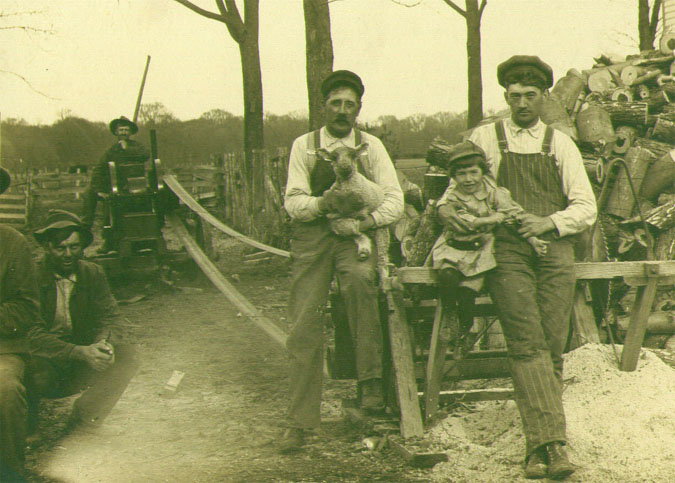
William Pritchard (on tractor), Guy Chambers, Fred Immke and Jim Pritchard on the farm. |
Then William was married to NELLE ELLEN WINTERS on the 17 Feb 1909 in Saunemin. She was born to 55 year-old A.C. Winters and his third wife, 29 year-old Louisa Edith Potter, on 24 Feb 1885, but had been orphaned before the age of ten. She then grew up with a widowed half-sister over 30 years her senior, Alfretta "Retta" Winters Brown, on a farm in Saunemin.
Nelle and Will lived near the farm of his sister Mary Jane Pritchard-Immke, as well as Nelle's paternal uncle Ira M Winters and maternal uncle Henry C Potter. They were a socially active couple, and became members of the Banner Literacy Society, which was in existence from 1889 to 1894. All the Winters and Pritchards belonged to the society (there were over 150 members). R.T. Brown, Nelle Winters and "Willie" Pritchard often gave recitations at their meetings. William was also a fine photographer, which accounts for the quality of many of the shots on this page. But his favorite hobby was, quote, "Chewing the rag with anyone who will listen to me." That hobby would serve him well in his later political career.
| Personal Information |
Census Image |
| Name: |
|
William Pritchard |
| Age in 1910: |
|
30 |
| Est. birthyear: |
|
1880 |
| Birth place: |
|
Ohio |
| Home in 1910: |
|
Saunemin, Livingston, Illinois |
| Series: |
|
T624 |
| Roll: |
|
303 |
| Part: |
|
2 |
| Page: |
|
124A |
|
|
|
| Personal Information |
Census Image |
| Name: |
|
W C Pritchard |
| Age in 1920: |
|
39 |
| Est. birthyear: |
|
1881 |
| Birth place: |
|
Illinois |
| Home in 1920: |
|
Sylvan, Washtenaw, Michigan |
| Series: |
|
T625 |
| Roll: |
|
800 |
| ED: |
|
161 |
| Image: |
|
240 |
|
|
|
SOURCE INFORMATION: Data imaged from National Archives and Records Administration. Washington, DC: National Archives and Records Administration.
|
| Personal Information |
Draft Card |
| Name: |
|
William C Pritchard |
| Status: |
|
Natural born citizen |
| Occupation: |
|
Self-employed |
|
|
|
SOURCE INFORMATION: National Archives and Records Administration. World War I Selective Service System Draft Registration Cards, 1917-1918. Washington, D.C. Registration Location: Washtenaw County, Michigan; Roll: 1682904; Draft Board: 0.
|
|
In December of 1914, Will and Nelle auctioned off six horses, 12 cows, 18 hogs, 30 Shropshire ewes and various farm implements, and moved to Chelsea, Michigan. They started a farm on land that is today the Chrysler Proving Grounds of Chelsea (there's still a Pritchard Street on the grounds, named after the farm). In addition to the farm, William was extremely active in the community, like his father. A natural talker and administrator (hence, a politician), he became a member of the Red School Board, the Chelsea Farm Bureau and the U.S. Agricultural Stabilization and Conservation Board of Washtenaw County. He also had served as township highway commissioner, worked on the Farm Loan Association, the PMA committee, the FHA committee, and was a prominent member of the Methodist Church. Will even became a justice of the peace in 1948.
|
| Personal Information |
Census Image |
|
| Name: |
|
William Pritchard |
| City: |
|
Sylvan |
| County: |
|
Washtenaw |
| State: |
|
Michigan |
| Year: |
|
1930 |
|
|
|
|
Roll: 1030; Page: 6A; Enumeration District: 41; Image: 99.0.
|
|
Their daughter, Dorothy, remembers of life on the Pritchard farm, and it should be noted that all of her recollections involve some sort of chore and hard work: "To put hay up in the hay barn you used three slings. They layered over each sling with hay and then it was raised and moved over mow. We had a hay loader that picked up hay and put it on wagon. Horses, wagon, and then hay loader in back to load the wagon. Chains with an elevator brought up the hay. There were two horses on the wagon... and certain marks on wagon so you could see how much you had. Someone was on back to distribute the hay. We unhitched the hay loader and drove up to barn to unload. I took care of the horses on the wagon. Most every load when I got older. Three slings distributed per wagon. There was a person in the mow who guided the hay over to where it would go and then let go the rope that opened the sling to drop the hay. I put the slings over the wagon and the last one on the bottom of the wagon to start the process over again. We had a hired man. We had 160 acres including the woods. There were marshy areas. So all the land was not farmed."
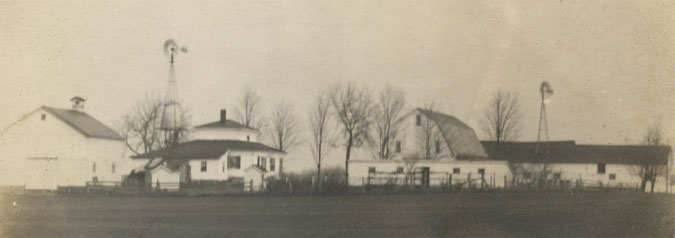
The Pritchard farm in Michigan, circa 1915. The land is now the Chrysler Proving Grounds. |
|
| Article Information |
Image |
|
| Title: |
|
Let's Get Acquainted with William Pritchard |
| Newspaper: |
|
The Washtenaw County Farm Bureau News |
| County: |
|
Saline, Washtenaw Co. |
| State: |
|
Michigan |
| Date: |
|
July, 1950 |
|
|
|
|
They also grew much of their own food, including William's favorite food, fresh strawberries with ice cream (a preference that he passed on to his children). He also grew corn for popping, and Sunday night was "popcorn night." Dorothy preferred it with salt and butter, while Helen liked it in a bowl of milk.
Nelle was an expert at making the popcorn, ice cream, and other treats. Dorothy remembers, "My mother canned plums, cherries, and peaches. Jellies and jams were quince and grape together, cherry, raspberry, strawberry, huckleberry—whole huckleberries if I had a lot... North of the road was a huckleberry marsh, at Gottlieb Sager's. We went there when we were teenagers. We used them for pies and sauce. We canned corn, beans, a big pressure cooker. I still have it, but have not used it since freezing is easier and safer now. I only can tomatoes now. I canned about 40 quarts last year, the least. I strain mine, but I like them better that way. I cook with skin and then strain in a food mill. I use onion, garlic, pepper and celery with tomatoes. Heat to boiling again then can, open kettle method."
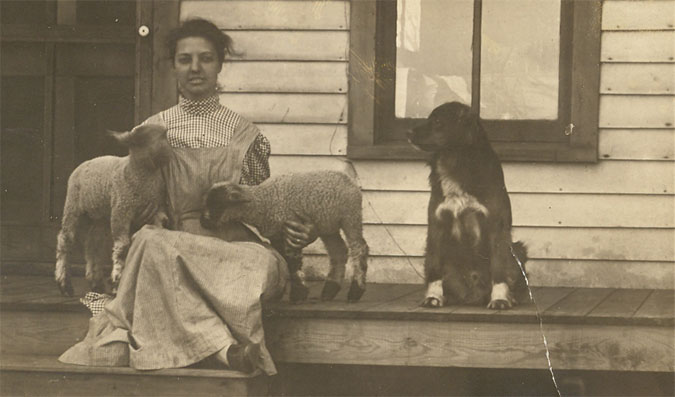
Nelle Winters-Pritchard and friends. |
|
| Personal Information |
Census Image |
| Name: |
|
WC Pritchard (Nelle W) |
| Age: |
|
70 |
| Birth year: |
|
1880 |
| Birthplace: |
|
Illinois |
| Home in 1950: |
|
Sylvan, Washtenaw, Michigan |
| Dwelling: |
|
117 |
|
|
|
|
SOURCE INFORMATION: Bureau of the Census; Washington, D.C.; Seventeenth Census of the United States, 1950; Record Group: Records of the Bureau of the Census, 1790-2007; Record Group Number: 29; Residence Date: 1950; Home in 1950: Sylvan, Washtenaw, Mich.
|
|
|
"We had good home butchered meats. They'd kill 2 or 3 pigs—Uncle Charlie, Uncle Frank, Grandpa and Ernest Schiller worked together. Each one had their own job. Grandpa cleaned casings, cooked them, back on wood range to sterilize them, salt them probably. Ernest was main sausage man. There was a grinder. They would test samples on the stove to see if it was made right. Cinnamon, allspice and other spices were used. They'd kill them, collect blood, scald them, scrape off hair, then hung them up, halved them, hung them into quarters. They made hams from hind legs, front quarters were roasts and of course pork chops. Liver went to liverwurst, nose, ears were ground for liver and blood wurst. We always put in garlic and onion. Some did not use garlic. Some used sage instead of garlic, also pepper, salt and spices. Sausage today is not the same. Most people smoked their own hams, My dad made a sugar brine, wrapped them in brown paper and hung in granary. They would bury eggs in the oats for winter storage. Most used oak wood with a slow fire."
Feeding the chickens was Dorothy's favorite task. Why? Because Nelle used to sew clothes out of the cloth bags that held the chicken feed. "I used to pick out dress patterns while I fed them."
CHILDREN OF WILLIAM PRITCHARD AND NELLE WINTERS |
|
DOROTHY IRENE PRITCHARD was born on 15 Apr 1918 in Chelsea, Washtenaw Co., Michigan. She married ERWIN WENK and had six kids: Martha Ellen, Irene Edith, Donald Erwin, Charles Martin, Paul William and Jean Marie.
Birth announcement here.
|
|
HELEN ALFRATA PRITCHARD was born on 06 May 1919 in Chelsea, Washtenaw Co., Michigan. She married HAROLD LESTER A. HARRISON, also of Chelsea, MI, on 29 Dec 1940, and they had two kids: ALFRETTA (b. 04 Sep 1953, and married DENNIS GRIEB) and WLLIAM (b. 22 Jan 1955). Helen lived in Chelsea her entire life. She was very active member of the First United Methodist Church of Chelsea and taught Sunday school for many years. She died on 01 Aug 2001, and is buried at Oak Grove Cemetery, Chelsea.
|
| Newspaper Article |
Image |
| Title: |
|
WC Pritchard: Justice of the Peace Succumbs to Illness |
| Subject: |
|
Obituary |
| Original Publication Date: |
|
June 23, 1958 |
|
|
|
William died at age 78—young for his family—at his home at 1187 Chelsea-Manchester Road, Sylvan township, after a long illness.
William was the last living of the four Pritchard brothers, but he left behind his two sisters: Mrs. Margaret Sims of Forest, Ill., and Mrs. Martha Albin of Clarksburg, Mo. He also left behind a beautiful wife—who was very long-lived herself and stayed alert and active for sixteen more years—and two daughters, by then named Mrs. Dorothy Wenk and Mrs. Helen Harrison, who both still lived near the Pritchard home in Chelsea; as well as eight grandchildren. He also left a long list of friends and constituents.
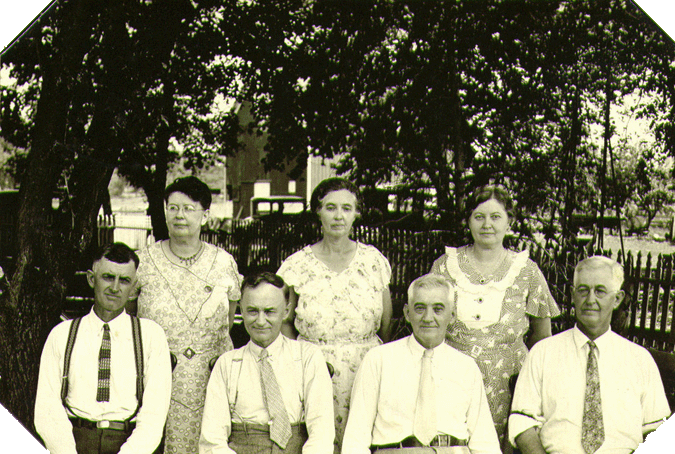 |
PRITCHARD FAMILY MEET TOGETHER AFTER 29 YEARS |
|
A family reunion of four brothers and three sisters of the Pritchard family—the first time in 29 years that the family had all been together—was held Monday September 3 at the William Immke home near Saunemin. John Pritchard, of San Francisco, Calif., has been visiting here the past few weeks and expected to return to his home soon, and inasmuch as only another sister living in Missouri would complete the family circle, it was decided that she should be present and Clarence Immke drove to her home and brought her here last Saturday for the occasion. The following are members of this family, whose parents Mr. and Mrs. John Pritchard, Sr., resided northwest of Wing where the family were raised: John Pritchard, San Francisco, Calif.; D. J. Pritchard, Pontiac; William C. Pritchard, Chelsea, Mich.; Frank Pritchard, Fairbury; Mis. Mary Immke, Saunemin; Mrs. Margaret Sims, Forrest, and Mrs. Martha Albin, of California, Mo. (Fairbury Blade, Friday, 08 Sep 1933, page 3)
|
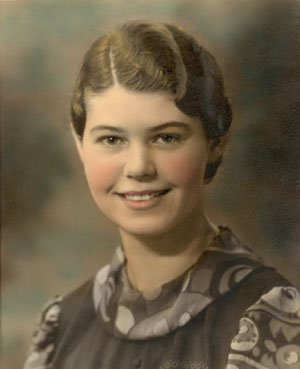
Dorothy Pritchard |
|
DOROTHY IRENE PRITCHARD was born on April 15th in 1918: Tax day in the United States, and therefore her birth is the only thing about that day that any of us appreciate.
She inherited the family work ethic: "There were no school on snow days. The teacher boarded near the school, and we put socks over our boots to keep snow out. When my mother got up she cooked cereal, like oatmeal, Malt-o-Meal and Cream of Wheat. We'd wash dishes after each meal—washed and dried. Made pies, cakes and cookies. Then it was time to start dinner. Mother took care of the kitchen and we took care of other rooms. Picked berries; we had blackberries (lots of thorns). She canned them. We had currents, and she made current pies for dad. We also had gooseberries. We had a semi-sweet cherry and needed a ladder to pick them as it was a large tree. I was not afraid of heights and usually did that.
Sometimes she had to split wood for the fire. For the kitchen stove she had a gasoline stove if it was too hot to have a kitchen. We had to carry in water for drinking and cooking. We had a cistern pump for other water. She did washing the first part of the work and ironing. Rolls she would start the night before, to raise overnight. We placed the bowl near the fire for warmth. I always started mine in the morning."
We had eggs to gather. She had customers at the end of the week, so she would dress chickens and make butter for customers. Our butter was all homemade. We had our own lard, butchering and then rendering the lard in the house. We put the crocks of lard in the basement, covering them with something. I don't remember what. Soap we made sometimes. I think you needed tallow for better lard. We did not make candles."
We had a delco plant for electricity... We did not use kerosene. Others used lanterns and lamps. The plant was in the basement and ran electricity for barn and house. She had a special iron and had to get another one when Consumers power came in. Don't know if it was there when my parents bought the place, or if it was put in later."
| Funeral |
File Image |
| Subject: |
|
In Loving Memory of Dorothy Wenk, 1918-2010 |
| Funeral Date: |
|
9 Sep 2010 |
| Location: |
|
Zion Lutheran Church |
| Eulogy: |
|
by Martha Hause |
|
|
|
|
Dorothy was the last descendant of this particular line to be born with the Pritchard name. She lived on a one hundred, forty-eight acre farm in Chelsea, Michigan, the size of which her great-grandfather, David, could not possibly have imagined from his small, humble cottage in Wales. She was the matriarch of our family, and the entire clan revolved around her warm, loving, generous presence.
Dorothy lived 92 years, sharing the long-lived fortitude of her Pritchard ancestors, and outliving her husband, ERWIN WENK, by twenty-eight years. She inherited all of the virtues of her father: his gregarious nature, his love of farming, and especially his love of ice cream (although, sadly, she was allergic to strawberries). Dorothy shared the her father's tireless work ethic, waking up early every morning well into her nineties, uncomplaining, to harvest crops for food (lying on her back underneath the plants in order to hold the pea pods up in the sunlight to see if they were ready to pick) and baking the best cherry pies I'd ever tasted (one sweet and one sour, baked especially for me), or picking flowers to make a nice arrangement on the dining room table.
Unlike the Prichards of old, she wasn't royalty or part of any court, but she was revered by us more than any queen could be, and she made our life richer than any nobleman or woman ever could.
So while the Pritchard name has disappeared from our line, the industriousness, determination and work ethic of this family have not.
|
L-R: Baby Dorothy; Dorothy and Helen with W.C. And Nelle; on the farm; with Nelle and Paul and Mabel Winters; Dorothy with baby Martha, 1940; Dorothy with daughters Martha and Jean at the graves of William and Nelle in Chelsea, in 2005.
|
In 1933, the American Pritchards gathered for a family reunion, the only time such an event ever occured. John Jr. was living in San Francisco, and many of the other family members could barely afford the trip. The children of John posed proudly, below, with their families. John, who left his homeland behind and braved the Atlantic crossing to give his descendants a chance for a better future, and his father David, the poor quarryman from Wales, would have been proud (click here to enlarge):
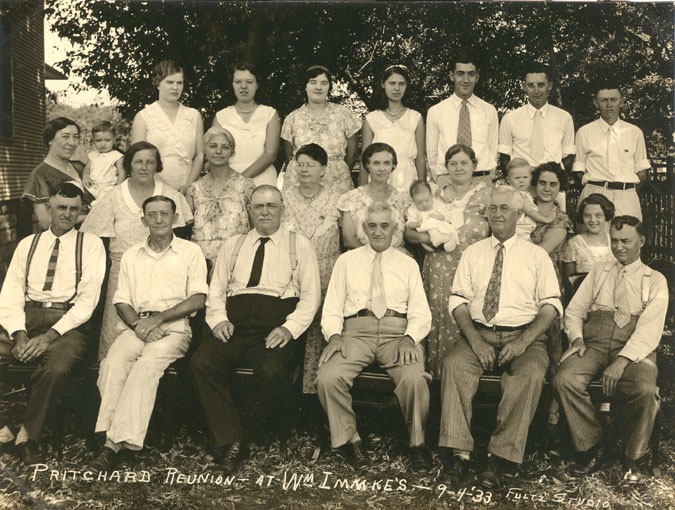
Front Row, L-R: Frank Pritchard, William Immke, Burr Simms, Jim Pritchard, William Cline Pritchard, John Pritchard.
Middle Row: Katherine Pritchard (wife of Jim, holding Jimmy Pritchard), Lucy Pritchard (wife of Frank), Nelle Pritchard (wife of William), Margaret Sims, Martha Albin, Mary Immke (holding Paul Immke), Iris Sullivan Pritchard (wife of Marian, holding James Clark Pritchard), Wilma Pritchard.
Back Row: May Immke, Helen Pritchard, Mary Sims, Dorothy Pritchard, Marian Pritchard, Clarence Immke, Arnold Immke. |
NOTES ON THIS PAGE
¹—Prichard is a Welsh "patronymic surname"—which means that it's derived from a modification of the father's name. Usually this happens when someone affixes 'son' to a name, as in Williamson (William's son) or Johnson (John's son, get it?). In this way, the Normans took the Latin word for son, filius (which they spelled Fitz), and used it as a prefix in names like Fitz-Alan and Fitz-Gerald. Similarly, the Gaelic Mac (son) was used in names like MacAdam or MacAlister. The Welsh did the same thing, but their word for 'son' is spelled Map, which over time was shortened into the prefix Ap. Eventually the 'p' coalesced with the first letter of the name, the 'a' was dropped altogether, which created names like Price and, of course, Prichard (or as it finally became spelled in our family history, Pritchard), which therefore means "son of Richard."
²—Welsh surnames are relatively few in number, but they have an inordinately large number of spelling variations. There are many factors that explain the preponderance of Welsh variants, but the earliest is found during the Middle Ages when Welsh surnames came into use. At this time, there were no uniform spelling rules and because the general population was illiterate, they could not specify a particular rendition of their names. Therefore, scribes and church officials recorded names as they sounded, which often resulted in a single person's name being inconsistently recorded over his lifetime. The transliteration of Welsh names into English also accounts for many of the spelling variations: the unique Brythonic Celtic language of the Welsh had many sounds the English language was incapable of accurately reproducing. It was also common for members of a same surname to change their names slightly, in order to signify a branch loyalty within the family, a religious adherence, or even patriotic affiliations. For all of these reasons, the many spelling variations of particular Welsh names are very important. Variations here include Pritchard, Prichard, Prickard, Prisiart, and many others.
If Wales is part of the British Empire, why does the Welsh language sound so different than English? England and Wales have a very complicated history. The Britons (Britanni) were the native inhabitants of Roman Britain, and spoke the Common Brittonic (Celtic) language, which evolved into Welsh, Cornish, Cumbric and Breton. When the Roman legions left in the early 5th century, there was a mass migration of Angles, Jutes, Saxons and other Germanic peoples from the war-torn European mainland to England. Those Angles, Jutes, Saxons and other Germanic peoples in turn went to war with and conquered the native Britons (Brythons), who moved west and established independent kingdoms such as Gwynedd, Powys, Gwent, and (under Irish influence) Dyfed in the more mountainous and remote regions. The Battle of Chester in 616, won by the Angles of Northumbria over the Britons, contributed to the isolation of the Welsh people. By 730, the English historian Bede described the conquered Britons of Wales as "for the most part, through innate hatred... adverse to the English nation." By the 11th century, the various kingdoms in Wales had developed a national identity as the "Land of the compatriots" (Cymru), in contrast to the Saxons (Saeson) in England, where the Anglo-Saxon language supplanted the old Brittonic languages. In the Anglo-Saxon English language, "Wales" and "Welsh" (meaning "foreigners") came to be used to describe the free lands to the west. Going from being labeled as "native Britons" to "foreigners" did not improve the Welsh view of the Saxons on the English mainland.
³—On 1 July 1837 a civil registration system for births, marriages and deaths was introduced in England and Wales. Registration was undertaken by civil registrars who reported to the Registrar General at the General Register Office (GRO) in London, now part of the Office for National Statistics (ONS). Copies of anyone's birth, marriage or death certificates can be obtained by the public. They are vital to family historians because of the genealogical information that they include." (Mark D. Herber, Ancestral Trails, Genealogical Publishing Company, Inc., 1998) Since the original birth, marriage and death registers are not open to the public, getting access to the information on one of these certificates is done by first searching the national birth, marriage and death indexes, that have been created by the GRO for this purpose. The indexes for the three events are each divided into quarterly volumes, with the names for each quarter listed alphabetically. Once an entry in one of the indexes is found, you are then able to use that information to order of copy of a death, marriage, or birth certificate from the GRO/ONS. Records in Wales show that a John Pritchard was married in "Brecknock" in 1854, between October and December (Vol. 11 B, Page 278). Today, Parish registers are held, at the National Library of Wales and/or Powys Archives for baptisms 1813-1984, marriages 1813-1873, burials 1813-1986 and banns 1826-1862 and 1957-1959. Also, at Cardiff Central Library and NLW, are records of baptisms 1738-1812, marriages 1738-56 and 1765-1812, and burials 1738-1812. Bishops' Transcripts, for various periods, are also held at NLW.
⁴—There appear to be two David Prichards in the area, and both married into a THomas family, our David to Gwen Thomas and the 2nd David to an Anne Thomas, about a decade earlier. Before Nazareth Church was built in 1818... "mansions and farmhouses in and near Llangamarch continued the tradition of housing Methodist meetings, as they had done from the early days. Such houses were Llwynmadog, home of the Thomas family of Abergwesyn, and Dôlgaer in Llangamarch, the old mansion of the Stedmans, which became the home of Edward Thomas' daughter Anne on her marriage to David Pritchard. Here Methodist preachers were often given hospitality." (Parishes of the Buzzard, pages 72-73)
Abergwesyn today is part of Llanwrtyd Wells (Llanwrtyd is 'church of St Gwrtud"), a market town and community in Powys, in the historic county of Brecknockshire (Breconshire) on the Afon Irfon. In 1907 part of Llanwrtyd was converted into an urban district called Llanwrtyd Wells. Llanwrtyd Wells Urban District was abolished in 1974, with its area becoming a community instead. The community includes the smaller settlements of Llanwrtyd and Abergwesyn, the valley of the Afon Irfon, and a large part of the "Desert of Wales," with a population of just 850 people. Llanwrtyd Wells grew in the 19th century as a spa town around the Ffynnon Ddrewllyd ("stinking well"), 1.5 miles from the much older settlement of Llanwrtyd. The town is the site of both the 'World Bog Snorkelling Championships' and the annual 'Man versus Horse' Marathon, as well as other annual events.
 |
⁵—Steamship City of Washington was 319 feet long and 40 feet wide, and was part of the Inman Line, built in Glasgow by Tod and McGregor in 1855. That year it was chartered by the French government, to be used for 18 months as a transport during the Crimean War. After that it began making runs between Liverpool and the United States, first to Philadelphia, then to New York. She had a clipper stem, with one funnel and three masts (rigged for sail, made of bark), and iron construction. She made a speed of 10 knots. In 1873 it wrecked off Cape Sable, when it struck a reef in broad daylight. The accident was blamed on a drunken first mate, who was guiding the ship while the captain was sick in bed.
SOURCES FOR THIS PAGE
 |
Parishes of the Buzzard, by Ruth Bidgood. Published by Gold Leaf Publishing, 3 Crown Street, Port Talbot SAI31BG (2000); Paperback 269 pages; ISBN: 0907117805. "This book is about Abergwesyn, a remote village in the mid-Welsh hills; a village that is still alive, though its churches, schools and inns are gone, its every valley holds ruined houses and disused fields, and man of its farms and sheepwalks have been lost to forest and reservoir. The book is not a lament or an exercise in nostalgia, but a celebration of a village typical of rural Wales, yet individual to the point of eccentricity." Ruth Bidgood was born in Seven Sisters, the daughter of the Rev Herbert Jones and his English wife, Hilda (nee Garrett), an elementary school teacher, in 1922. She was educated at Port Talbot secondary school and St Hugh's College, Oxford. In 1943 she joined the Women's Royal Naval Service (the Wrens) and worked in Alexandria, Egypt, as a coder, a job she later said was "akin to writing poetry"—that is, searching for the right and precise word. She then worked in London for Chambers Encyclopaedia. She married David Bidgood in 1946, had three children and lived mainly in Coulsdon, Surrey, although in the mid-60s the family bought a bungalow in Wales's "green desert" of Abergwesyn for summer holidays. "The call of the land and the ruins" inspired her to start writing poetry and investigating the past. She published several poems in magazines and a first collection, The Given Time, in 1972. But soon afterwards her husband left her, and the "corrugated iron cottage" miles from anywhere became her permanent home. Fourteen volumes of poetry followed; she continued writing well into her 90s about the harsh landscape, standing stones, crumbling churches, neglected gravestones and abandoned slate mines around her home. The stories of vanished people "who lived here and are not remembered" were reconstructed in her poetry and in more than 70 scholarly articles. She left behind fifteen collections of poetry, including no less than three Selecteds, and the Roland Mathias Prize-winning Time Being (2009), perhaps her finest book, published when she was 87. She was elected a fellow of the Welsh Academy and an honorary fellow of Aberystwyth University. She died on 4 Mar 2022, just shy of her 100th birthday, leaving behind two sons, Tony and Martin, eight grandchildren and nine great-grandchildren. Her daughter Janet had died at a ripe old age—fifteen years earlier. (Serenbooks.com)- A history of the County of Brecknock, Vol. 1 & 2, by Theophilus Jones (1759-1812). was published in two volumes in Brecon in 1805 and 1809. It was reprinted in one volume in 1898; and in a considerably enlarged form in four volumes, edited by Joseph Bailey, 1st Baron Glanusk, in 1909 to 1930. This version was published and sold by Blissett, Davies & Co., Brecknock, 1909. Page 220: "Llanvihangel Abergwessin, or St. Michael's on the Fall of Gwesin. That in which Llwynmadoc, the mansion of the late Evan Thomas, and of Henry Thomas and David Thomas, esqrs., is situated, is remarkably romantic and beautiful. This family is descended from one of the younger branches of the house of Elystan Glodrydd ; they have been possessed of a tenement called Llwynmadoc, in this parish, for some centuries, but prior to the increase of fortune by the late Mr. Evan Thomas, which was acquired by industry and application to business, as well as by marriage, they were not of sufficient importance to be noticed by the heralds : the first we find is Evan Thomas ap Meredith, who died in 1676, and who left issue Meredith Bevan, Thomas Bevan, and Rees ap Jeuan : Thomas purchased Llwynmadoc, from his eldest brother, and died in 1695, leaying Edward Thomas (who married Winifred Evans of Blan y cwm) to whom he devised Llwynmadoc ; Mauld, of whom we know nothing ; William Thomas, to whom he devised Tyr yr Dryscol, and whose child, William, died without issue, Meredith and David. Edward Thomas left issue the late Evan Thomas, esq., many years agent to Lord Weymouth, since marquiss of Bath ; he married a daughter of Thomas Waters, and secondly Miss Jones of Cribarth. Edward Thomas, who married Catherine Davies of Sarn y geifr, Mary who married Evan Lloyd of Cwmemliw, and Anne married to John Price of Castell bach. Evan Thomas, the eldest son of the first Edward, had issue Henry Thomas, living about 1800, who married Miss Gwynne of Glynairon, and Thomas Thomas, who died without issue. Edward Thomas the second had issue Edward Thomas, esq., deceased, who married, first Letitia Price of Maes yr onn, and secondly Anne Evans, widow, sister of David Jones of Llwynderw and daughter of Peter Jones of Dugoedy,1 David Thomas of the Pay Office London, and Evan Thomas who died without issue. Henry Thomas had issue, Evan, Mary and Anne ; and Edward, his first cousin had issue by his first wife, Evan Thomas, who died without issue, and by his second wife, Anne, married to David Prichard, the younger, of Builth, gent., and David Thomas married to Catherine Jones of Ystradwalter. Llwynmadoc may perhaps have been the mansion or temporary residence of Madoc ap Bleddin ap Cynfyn, prince of Powys, upon the expulsion of Rhys ap Tewdwr into Ireland, until the defeat at Llechryd with his brothers, Ryrid and Cadwgan, upon his return, but this is given merely as conjecture and not history."
- Genealogical work on the David Pritchard and Gwen Thomas families by Brian Hemmings, 1 Marianwen St., Blackwood, Gwent, NP12 3ST, S. Wales.
- Breconshire Local & Family History Society (Cymdeithas Hanes Lleol & Theuluoedd Brycheiniog) "was established in June 2011 to enhance, encourage and enable the study of local history and family history in the mid-Wales county of Breconshire."
- England & Wales Hardwicke Marriage Index, 1754-1837; Llanwrtyd St David: #107, 20/02/1800 shows John PRICHARD of Llanfihangel Abergwesyn to Abigail WILLIAMS; #64, 10/05/1826 shows Rees WILLIAMS, Single, to Anne PRICHARD, Single.
- St Michael's Church, Llanfihangel Abergwesyn, as reported on Coflein, the online database for the National Monuments Record of Wales (NMRW)—the national collection of information about the historic environment of Wales. "It contained several notable monuments to the Thomas family of Llwynmadoc dating back to the seventeenth-century. The church was demolished in 1964, although the churchyard remains which contains a notable memorial cross to the Thomas family of Llwynmadoc."
- Rob Graves disentangles the many branches of the Thomases of Powys: The Thomases of Powys really knew what's in a name. The dauntless Rob Graves takes a scholar's scalpel to disentangle the many branches of a family tree with claimed roots in Saxon times that loomed so large over Radnorshire. (The Journal of the Kilvert Society, Number 41, September 2015, pages 359-364)
- Victorian Llanwrtyd: A 19th Century history of Powys, designed for schools.
- Abergwesyn 1840 Revival: Pressing in for More: A review of the book 'Parishes of the Buzzard', by Ruth Bidgood (2000): "Many of the interesting first and second hand accounts of revivals in Wales which happened earlier than 1859 are to be found in the religious journals, biographies and histories which were published in Welsh in the 19th century. Most of these are still untranslated, and so effectively remain out of the reach of any but Welsh speakers. Occasionally they get translated or summarised and the accounts appear in books written more recently in English. This account is one of these." (from welldigger, a blog seeking to honor the work of the Holy Spirit in Wales through accounts of people, places and events.)
- Abergwesyn : Bwlch y Ddau Faen. Bidgood, Ruth. Newtown, Powys : Gwasg Gregynog, 1997. 16p
- The Buildings of Wales: Powys, by Robert Scourfield and Richard Haslam (New Have, Yale University Press, 2013), pp. 423, 427; Cadw Listed Building Record, Ref No. 24532 (Thomas family churchyard monument)
- Churches and gentry in the Abergwesyn area. Bidgood, Ruth. Brycheiniog 21 (1984/85), p. 34-51
- Abergwesyn, y porthmyn a Ruth Watcyn. Gwyndaf, Robin. Medel 1 (1985), p. 34-40.
- Llanddewi Abergwesyn Baptisms 1813-1984; Marriages 1813-1873; Burials 1813-1986; Banns 1826-1862, 1957-1959 Parish Registers, or copies, for all or part of these dates are held at the NLW and/or Powys Archives. Also, at Cardiff Central Library and the NLW are Baptisms 1738-1812; Marriages 1738-56, 1765-1812; Burials 1738-1812; Bishops Transcripts for various periods are held at the NLW.
- Breconshire Local & Family History Society: Breconshire Local & Family History Society (BLFHS) was established in June 2011 to enhance, encourage and enable the study of local history and family history in the mid-Wales county of Breconshire.
- St Michael of All Angels, Llanfihangel Talyllyn, Breconshire: 2020 Photos of the church located in the center of Llanfihangel Talyllyn village some 7km to the east of Brecon, where James Prichard and Jane Lewis were wed and buried, with text extracted from History of Brecknock, by Theophilus Jones (written in 1809); 'Glanusk Edition Volume III', published in 1911. Brecon. The font is from the Norman era, as is perhaps the nave masonry. The doorway, porch, and west tower are all of c.1500, but the chancel was rebuilt in the 1870s (Source: The Old Parish Churches of Mid Wales by Mike Salter, Folly Publications, Malvern, Worcestershire, 2003).
- Portrait and biographical album of Livingston County, Ill. : containing full page portraits and biographical sketches of prominent and representative citizens of the county : together with portraits and biographies of all the governors of Illinois, and of the presidents of the United States, published by the Chapman Bros., Chicago (1888), pages 895, 896: "JOHN PRITCHARD, now a resident of Saunemin Township, is n native of Wales, in which country he resided until twenty -eight years of age. He was born on the 7th of October, 1832, and is the son of David and Guine Pritchard, the former a native of Wales, but of Scotch ancestry, as was also the mother. To the parents were born six children, named: Margaret, William, Eleanor, David, John and Thomas. The Pritchard family are all long-lived people, the father having reached eighty-five years and the mother ninety years. On the 3d of October, 1872, while living in Missouri, Mr. Pritchard was married to Mary M. Miller, a native of Pennsylvania, who was born on the 21st of November, 1851. To them were born seven children, whose record is as follows: John B. was born Sept. 23, 1873; Margaret E., Jan. 9, 1876; David J., April 12, 1878; William C., Feb. 11, 1880; Franklin T., Feb. 26, 1882; Mary J., Oct. 17, 1884, and Lavinia M., Sept. 25, 1886. Shortly after marriage, Mr. Pritchard came to Livingston County and settled on the farm on which he now resides, on the Vermilion River. His first purchase of land consisted of eighty acres, to which he subsequently added until he now has a farm of 160 acres, which is a model in all its appointments and equipments. When he became possessed of this land there had practically never been any improvements made upon it, nor any cultivation attempted. On the 13th of October, 1886, Mrs. Pritchard died after a short illness. She was a woman who had endeared herself by her many good qualities of head and heart, to all who knew her, and her loss, both to the family and the community, is sincerely mourned. Mr. Pritchard is a member of the Baptist Church, in which lie has served in the capacity of Deacon, and is also Superintendent of the Sunday-school. He is a Republican in politics, although he does not take an active part in political matters. He has never been an office-seeker, but on the contrary has declined political perferment when tendered by his friends."
- Late 19th-Century Maps Show Measles Mortality Before Vaccines, by Rebecca Onion, Slate, Feb 03, 2015. "These maps of measles mortality appeared in three late-19th-century statistical atlases published by the Census Office. Experiments in data visualization, the atlases are modern in their scope and ambition. Since they were compiled in a time before the availability of vaccines for most childhood diseases (with smallpox being the exception), they are a good record of the former pervasiveness of measles."
- "Mrs. Sims Notes 90th Birthday on the Same Farm Where She Was Born," The Fairbury Blade, Fairbury, Illinois, 13 Jan 1966.
- Descendants of William Prichard, by A. M. Prichard, Charleston, W. Va., March, 1912. Tribune Printing Co., W. Va.
- My Folks: Pritchard, Vaught, Beasley, Sargent, by Thelma Sargent.
 |
 |
|
















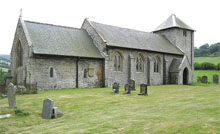
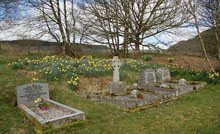
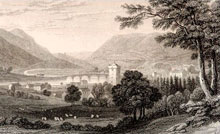
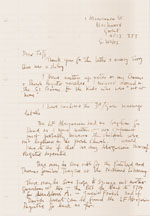


.gif)




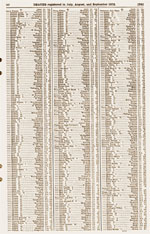
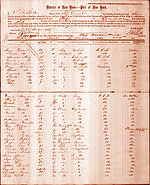
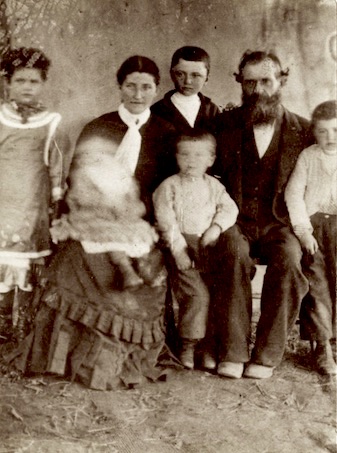
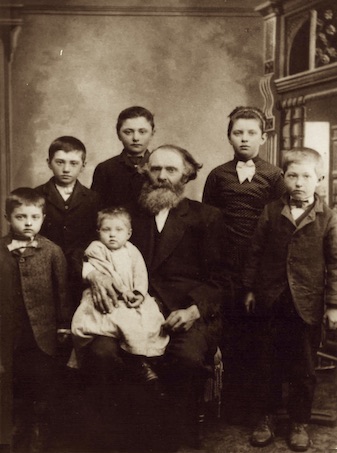
.gif)







